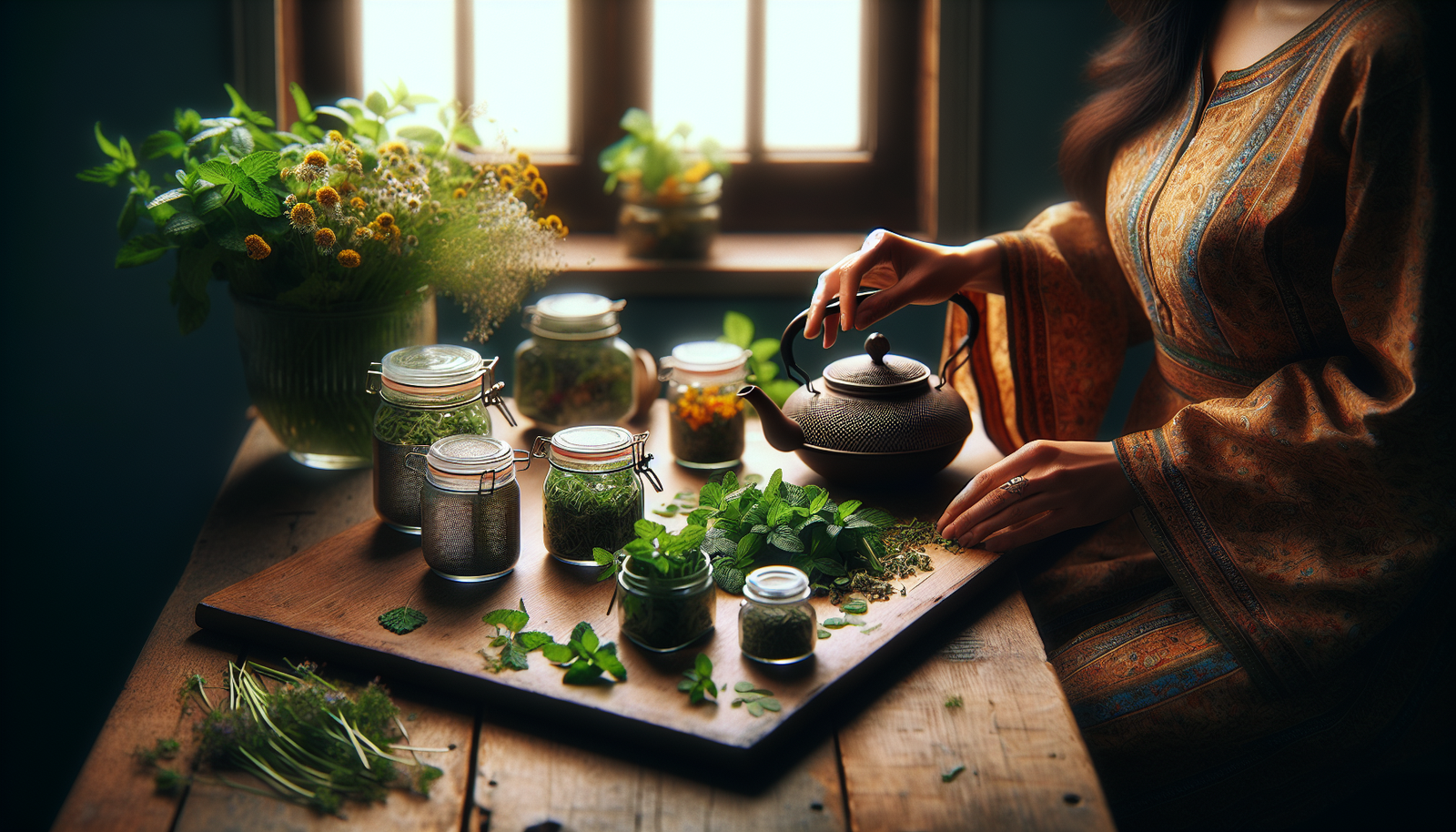
How to Make Herbal Teas Using Fresh Herbs
Make herbal teas with fresh herbs and unlock a world of flavor and health benefits right from your kitchen garden. Fresh herbs not only enhance the taste of your teas but also offer a potent array of natural nutrients. From calming chamomile to invigorating mint, crafting your own herbal tea blends allows you to control the ingredients and customize flavor profiles. This guide will walk you through selecting, preparing, and steeping fresh herbs to create aromatic teas tailored to your preferences. Dive in and start your journey towards flavorful, nourishing homemade herbal teas today.
The Benefits of Fresh Herbal Teas
Dive into the delightful world of fresh herbal teas, where the art of using fresh ingredients enhances both flavor and health. Fresh herbal teas are becoming a popular choice for those seeking a natural and refreshing alternative to traditional beverages. These teas offer a unique blend of flavors and aromas, coupled with a plethora of health benefits, making them a rewarding choice for both body and mind.
Enhancing Health with Fresh Herbal Ingredients
Fresh herbs are nature’s own remedy, packed with active compounds that offer several health benefits. Fresh herbal teas are rich in antioxidants, vitamins, and minerals, providing a healthy boost to your daily routine. Ingredients like mint, chamomile, and ginger are known for their anti-inflammatory properties. Consuming these teas helps in improving digestion, reducing stress, and enhancing sleep quality. Moreover, the direct use of fresh herbs ensures that the essential oils and nutrients remain intact, offering a more potent health benefit compared to dried herbs.
Using fresh herbs allows you to tailor your tea to specific health needs. For instance:
- Mint: Known for aiding digestion and reducing headaches.
- Chamomile: Famous for promoting relaxation and improving sleep.
- Ginger: Helps in reducing nausea and boosting immunity.
Each fresh herb brings its own set of benefits, making the experience of drinking herbal tea both enjoyable and nourishing.
Exploring the Natural Aromas and Flavors
The vibrant aromas and flavors of fresh herbal teas create a sensory experience that is both soothing and invigorating. Unlike dried herbs, fresh herbs release more of their natural oils, resulting in a richer taste and aroma. This freshness translates into a more satisfying and aromatic cup of tea that can be both calming and energizing.
The natural flavors offer a pure taste without the need for artificial additives. The subtle sweetness of basil, the citrusy notes of lemon balm, and the zesty kick of fresh ginger can tantalize the taste buds. Creating your own blend of fresh herbs allows for an exploration of flavors that caters to personal preferences, whether you enjoy a mild, earthy taste or a strong, spicy flavor.
Sustainable and Cost-Effective Herbal Tea Options
Choosing fresh herbal teas supports a sustainable lifestyle. Growing your own herbs reduces the environmental impact linked with the packaging and transportation of commercial tea products. It’s a more eco-friendly option that not only benefits the planet but also your wallet. Fresh herbs can be harvested directly from your garden or local market, eliminating the need for constant purchases of store-bought teas.
The cost-effectiveness of fresh herbal teas is evident when you consider the longevity and yield of a home herb garden. A single plant can provide numerous harvests over its lifetime. Here’s why this choice is beneficial:
- Reduced Waste: No unnecessary packaging or single-use tea bags.
- Continuous Supply: Herbs regrow quickly, offering a steady supply of fresh ingredients.
- Personalized Blends: Mix and match herbs to create unique blends tailored to your taste and health needs.
By opting for fresh herbal teas, you’re not only making a healthier choice but also contributing to a more sustainable future.
Selecting and Preparing Fresh Herbs for Tea
Creating the perfect cup of herbal tea begins with selecting and preparing the right herbs. This process ensures that you maximize the flavor and health benefits of your brew. Knowing how to choose, wash, and store herbs properly is essential for a delightful tea experience. With a little effort, you can enjoy fresh, aromatic, and flavorful teas that align with your personal preferences.
Identifying the Best Fresh Herbs for Tea Blends
Selecting the right herbs is crucial in crafting a tea blend that satisfies your taste buds and health requirements. Fresh herbs like peppermint, lemon balm, and rosemary are popular choices due to their robust flavors and therapeutic qualities. Each herb offers a unique profile:
- Peppermint: Offers a cooling sensation and aids in digestion.
- Lemon Balm: Known for its calming effects and subtle citrusy flavor.
- Rosemary: Provides a woody aroma and is known for enhancing memory.
When choosing herbs, look for vibrant colors and a strong aroma, indicators of freshness and potency. Consider growing these herbs at home to ensure a constant supply of fresh ingredients that allow for experimentation with different combinations and flavors.
Proper Washing and Storing Techniques for Fresh Herbs
Once you’ve selected your herbs, proper washing and storing methods are vital to maintain their freshness and quality. Washing removes any dirt or insects that may be present on the leaves. Gently rinse the herbs under cool water and pat them dry with a paper towel.
Storing fresh herbs requires a little attention to detail to maintain their freshness:
- Refrigeration: Place herbs in a damp paper towel, then store in a plastic bag in the refrigerator.
- Freezing: Chop herbs and place them in ice cube trays with water, then freeze. This method preserves their flavor for later use.
- Fresh Use: For immediate use, trim the stems and place them in a glass of water, much like a bouquet, and cover with a plastic bag to prolong their freshness.
These techniques ensure that your herbs retain their essential oils and flavors, ready for when you need them.
How to Harvest Fresh Herbs at Home
Harvesting herbs from your garden is both rewarding and economical. Knowing when and how to harvest ensures the best flavor and growth for future harvests:
- Timing: Harvest in the morning after the dew has dried. This is when oils are strongest.
- Snipping: Use sharp scissors or pruning shears to cut stems just above a leaf node.
- Regular Harvests: Regularly harvesting encourages continued growth and prevents flowering, which can alter the taste of the herbs.
These simple steps not only yield the freshest herbs for your tea but also promote a healthy and abundant garden. Enjoy the satisfaction of nurturing your own herbs and experiencing the freshest possible tea.
Brewing Techniques for Fresh Herbal Teas
Brewing fresh herbal teas is an art that enhances the flavors and benefits of your chosen herbs. The right technique transforms fresh ingredients into a soothing and aromatic beverage. From infusion methods to optimal brewing times, mastering these techniques will ensure that each cup of tea is a delightful experience.
Step-by-Step Guide to Infusing Fresh Herbal Teas
Infusing fresh herbal teas is simple yet rewarding. Follow these steps to achieve a perfect brew:
- Select Your Herbs: Choose fresh herbs based on desired flavor and health benefits.
- Prepare Herbs: Wash and dry the herbs thoroughly, then gently crush them to release their oils.
- Boil Water: Use fresh, cold water for boiling as it retains more oxygen, enhancing the tea’s flavor.
- Add Herbs: Place herbs in a teapot or infuser, then pour hot water over them.
- Steep: Allow herbs to steep for about 5 to 10 minutes, depending on the desired strength.
- Strain and Serve: Remove herbs, strain the tea, and serve hot or iced.
This method ensures that the essential oils and flavors are fully extracted, providing a rich and aromatic cup of tea.
Optimal Brewing Times and Temperatures for Fresh Herbs
Achieving the perfect cup of herbal tea depends on the correct brewing times and temperatures. Fresh herbs require specific conditions to fully release their flavors:
- Peppermint and Mint: Brew at 160-180°F for 5-7 minutes.
- Chamomile: Steep at 200°F for 4-6 minutes.
- Rosemary and Thyme: Infuse at 190-200°F for 7-10 minutes.
Adjusting the brewing time and temperature according to the herb preserves its natural flavors and ensures a pleasant taste. Over-steeping or using boiling water can result in bitterness, so it’s important to monitor the brewing process closely.
Creative Herbal Tea Blends with Fresh Ingredients
Experimenting with different combinations of fresh herbs can lead to exciting and unique tea blends. Creating your own blend allows you to tailor flavors and benefits to suit your preferences:
- Invigorating Blend: Combine mint, ginger, and lemon balm for a refreshing and energizing tea.
- Relaxation Blend: Mix chamomile, lavender, and lemon verbena for a calming and soothing experience.
- Immunity Boost: Blend thyme, rosemary, and elderflower to support the immune system.
These creative combinations not only tantalize the taste buds but also provide a range of health benefits. Tailor your tea blends to your daily needs and enjoy the diverse world of fresh herbal teas.
Conclusion
Herbal teas can be crafted using fresh herbs from your garden or local market. Common herbs include mint, chamomile, basil, lemon balm, and rosemary, each offering unique flavors and benefits. To prepare, rinse the herbs thoroughly and crush them slightly to release their oils. Steep the herbs in hot water for about 5-10 minutes to extract their essence. Adding natural sweeteners like honey or lemon can enhance the taste.
FAQ
How do you dry fresh herbs for making herbal teas?
Dry herbs by hanging them upside down in a warm, dark, well-ventilated area. Ensure they’re not exposed to direct sunlight to preserve flavor and color. Once crispy, store them in airtight containers away from light.
What are the best fresh herbs for herbal tea blends?
Great herbs for teas include mint, chamomile, lemon balm, and lavender. Each brings unique flavors and benefits, allowing for a variety of soothing blends.
How long should you steep fresh herbs for herbal tea?
Steep fresh herbs for about 5 to 10 minutes. This duration allows flavors to fully express while extracting beneficial compounds.
Can fresh herbs be mixed with other ingredients for herbal teas?
Mix fresh herbs with ingredients like citrus peels, ginger, or honey. Combining elements enhances taste and provides additional health benefits.
What are the health benefits of herbal teas made from fresh herbs?
Herbal teas offer various benefits, including improved digestion, relaxation, and boosted immunity. They’re rich in antioxidants and can help reduce inflammation.
How to store fresh herbs to maintain their potency for tea making?
Wrap fresh herbs in a damp paper towel, then place them in a sealed plastic bag in the refrigerator. This method maintains their freshness and potency for tea.











